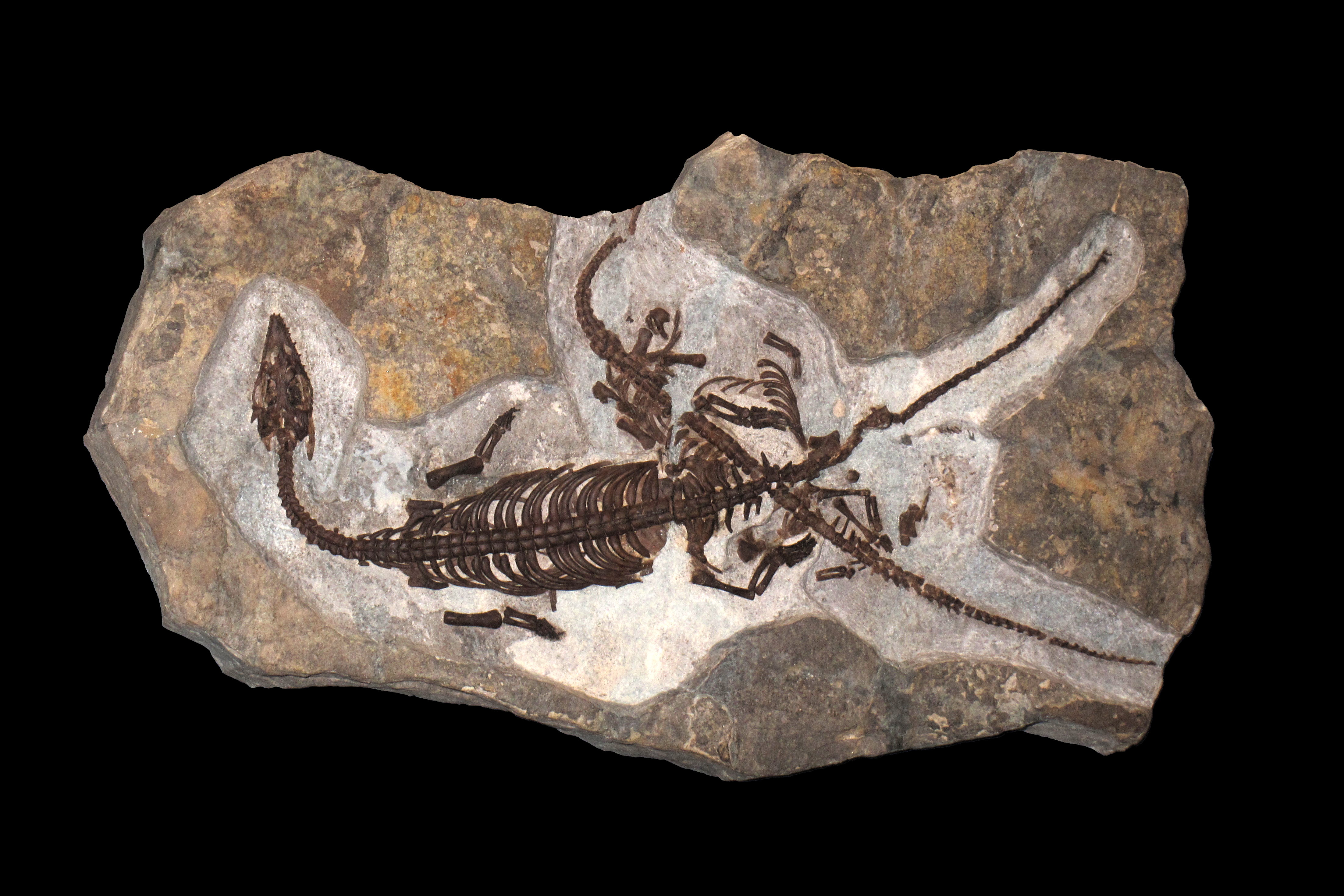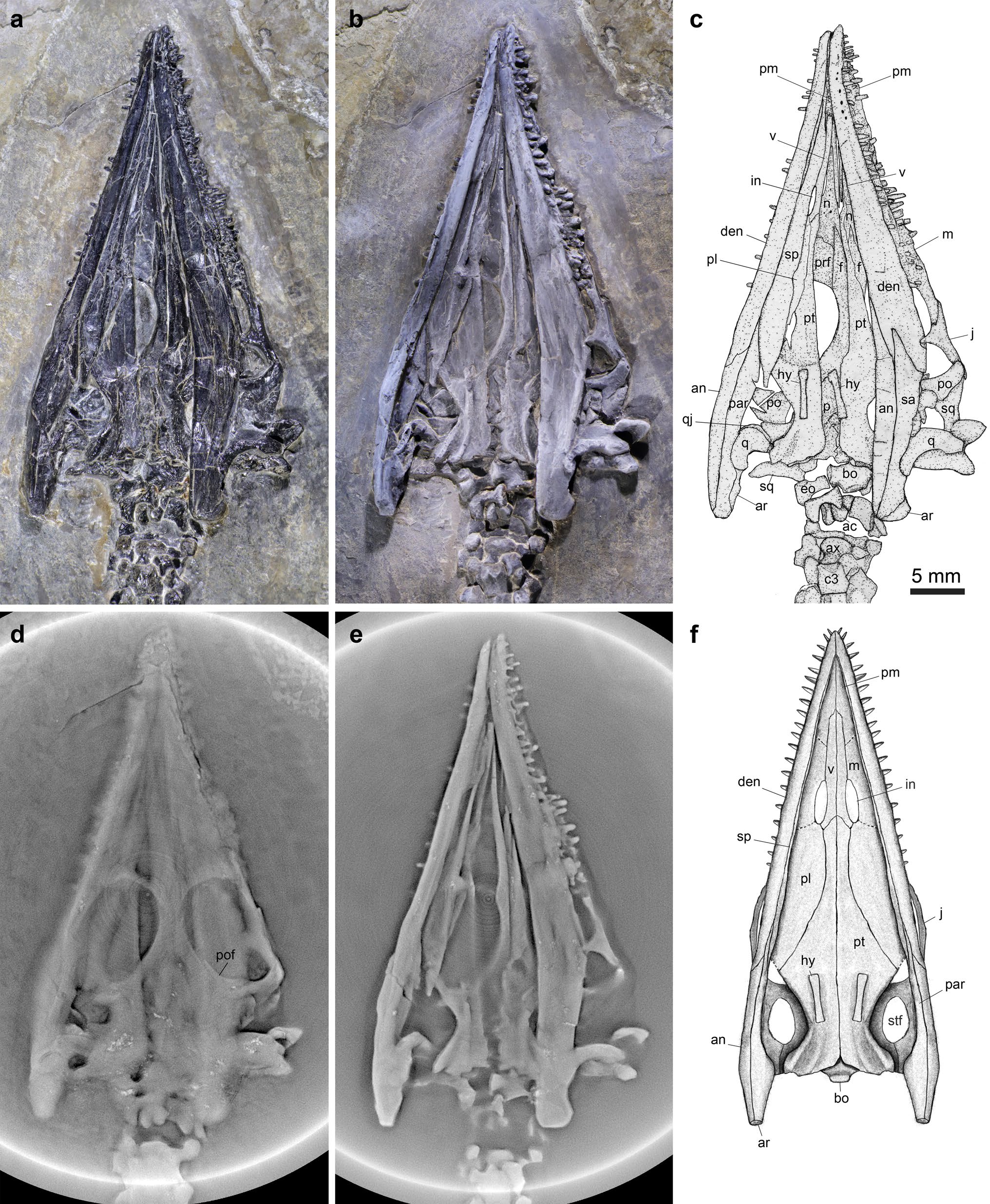|
Pachypleurosaur
left, 220px, '' Pachypleurosaurus'' Pachypleurosauria is an extinct clade of primitive sauropterygian reptiles that vaguely resembled aquatic lizards, and were limited to the Triassic period. They were elongate animals, ranging in size from , with small heads, long necks, paddle-like limbs, and long, deep tails. The limb girdles are greatly reduced, so it is unlikely these animals could move about on land. The widely spaced peg-like teeth project at the front of the jaws, indicating that these animals fed on fish. In the species '' Prosantosaurus'', it was observed that they fed on small fishes and crustaceans which they devoured entirely and that its teeth regrew after they broke off. This was the first observation of tooth replacement in a European pachypleurosaur, the only other discovery of such an event was made in China. Classification Pachypleurosaurs were originally and are often still included within the Nothosauroidea (Carroll 1988, Benton 2004). In some more rece ... [...More Info...] [...Related Items...] OR: [Wikipedia] [Google] [Baidu] |
Prosantosaurus
''Prosantosaurus'' is a monotypic genus of pachypleurosaurian sauropterygian containing the single species ''Prosantosaurus scheffoldi'' discovered in Canton Grison of Switzerland. The genus is named after the Prosanto Formation near the Ducan mountains, where the skeletons were found, and the species for Beat Scheffold, a scientific illustrator from Zurich who contributed prominently to the research of the Triassic marine reptiles. Discovery Six skeletons of the species have been discovered within lime and marlstone sediments of the Upper Prosanto Formation in the Ducanfurgga southeast of Davos, Canton Grisons, at about 2700 m above sea level. They have been dated to the very early Ladinian of the Triassic period. Today, the Ducan mountains are located about northeast of Mount San Giorgio, a UNESCO world heritage site where other pachypleurosauria were found. In the past, the two locations have been up to apart from each other. The skeletons are accessible in the palae ... [...More Info...] [...Related Items...] OR: [Wikipedia] [Google] [Baidu] |
Dianopachysaurus
''Dianopachysaurus'' is an extinct genus of pachypleurosaur known from the lower Middle Triassic (Anisian age) of Yunnan Province, southwestern China. It was found in the Middle Triassic Lagerstatte of the Guanling Formation. It was first named by Jun Liu, Olivier Rieppel, Da-Yong Jiang, Jonathan C. Aitchison, Ryosuke Motani, Qi-Yue Zhang, Chang-Yong Zhou and Yuan-Yuan Sun in 2011 and the type species is ''Dianopachysaurus dingi,'' thanking a Professor Ding for his help. ''Dianopachysaurus'' is most closely related to ''Keichousaurus'', another Chinese pachypleurosaur. Both belong to the family Keichousauridae. Pachypleurosaurs are hypothesized to have originated in the eastern Tethys Ocean (South China) before spreading and diversifying in the western Tethys in what is now Europe. A large ghost lineage of eastern pachypleurosaurs has long been inferred based on the phylogeny of the group. ''Dianopachysaurus'' represents an early stage in the radiation of pachypleurosaurs and ... [...More Info...] [...Related Items...] OR: [Wikipedia] [Google] [Baidu] |
Serpianosaurus
''Serpianosaurus'' is an extinct genus of pachypleurosaurs known from the Middle Triassic (late Anisian and early Ladinian stages) deposits of Switzerland and Germany. It was a small reptile, with the type specimen of ''S. mirigiolensis'' measuring long. Fossils of the type species, '' S. mirigolensis'', have been found from the middle Grenzbitumenzone, the oldest strata of Monte San Giorgio, Switzerland, an area well known for its abundant pachypleurosaur remains. The locality dates back to sometime around the Anisian/Ladinian boundary of the Middle Triassic, around 242 Ma, with ''Serpianosaurus'' most likely occurring strictly during the latest Anisian. This makes it the one of the oldest sauropterygians from Monte San Giorgio, with only the rare pachypleurosaur '' Odoiporosaurus'' being older. Certain aspects of its morphology also suggest it is one of the most basal forms. Cajus G. Diedrich in 2013 described and named a second species, ''S. germanicus'', based on a pos ... [...More Info...] [...Related Items...] OR: [Wikipedia] [Google] [Baidu] |
Luopingosaurus
''Luopingosaurus'' (meaning "Luoping lizard") is an extinct genus of pachypleurosaurid sauropterygian from the Middle Triassic Guanling Formation of Yunnan Province, China. The genus contains a single species, ''L. imparilis'', known from a well-preserved, nearly complete skeleton. Discovery and naming The ''Luopingosaurus'' holotype specimen, IVPP V19049, was discovered in sediments of the Guanling Formation, dated to the Anisian age (Pelsonian substage) of the middle Triassic period, in Luoping County, Yunnan Province, China. This specimen consists of a nearly complete, ventrally-exposed, articulated individual, lacking only the end of the tail. The preserved portion of the skeleton measures long. In 2023, Xu ''et al''. described ''Luopingosaurus imparilis'', a new genus and species of pachypleurosaurid, based on these fossil remains. The generic name, "''Luopingosaurus''", combines a reference to the type locality in Luoping County with the Greek word "saurus", meaning ... [...More Info...] [...Related Items...] OR: [Wikipedia] [Google] [Baidu] |
Keichousaurus
''Keichousaurus'' (key-cho-saurus) is a genus of marine reptile in the pachypleurosaur family which went extinct at the close of the Triassic in the Triassic-Jurassic extinction event. The name derives from Kweichow (now Guizhou Province) in China where the first fossil specimen was discovered in 1957. They are among the most common sauropterygian fossils recovered and are often found as nearly complete, articulated skeletons, making them popular among collectors. ''Keichousaurus'', and the pachypleurosaur family broadly, are sometimes classified within Nothosauroidea, but are otherwise listed as a separate, more primitive lineage within Sauropterygia. Description ''Keichousaurus'', like all sauropterygians, was highly adapted to the aquatic environment. Most specimens had small body, males sexually mature with snout-vent length (SVL), and in females by SVL. Mean SVL for mature males is approximately SVL, and for mature females, at most SVL. It had both long necks a ... [...More Info...] [...Related Items...] OR: [Wikipedia] [Google] [Baidu] |
Odoiporosaurus
''Odoiporosaurus'' is an extinct genus of pachypleurosaur known from the Middle Triassic (middle Anisian stage) Besano Formation (Grenzbitumenzone) of northern Italy. It contains a single species, ''Odoiporosaurus teruzzii''. ''Odoiporosaurus'' is the sister taxon of the group formed by ''Serpianosaurus'' and '' Neusticosaurus'', and together with the older and more primitive ''Dactylosaurus'' plus '' Anarosaurus'' clade, they form a monophyletic In cladistics for a group of organisms, monophyly is the condition of being a clade—that is, a group of taxa composed only of a common ancestor (or more precisely an ancestral population) and all of its lineal descendants. Monophyletic ... group of European pachypleurosaurids. References Triassic plesiosaurs Fossil taxa described in 2014 Fossils of Italy Anisian life Sauropterygian genera {{triassic-reptile-stub ... [...More Info...] [...Related Items...] OR: [Wikipedia] [Google] [Baidu] |
Nothosaur
Nothosaurs (order Nothosauroidea) were Triassic marine sauropterygian reptiles that may have lived like seals of today, catching food in water but coming ashore on rocks and beaches. They averaged about in length, with a long body and tail.F. v. Huene. 1956. Paläontologie und Phylogenie der Niederen Tetrapoden aleontology and Phylogeny of the Lower Tetrapods ''VEB Gustav Fischer Verlang, Jena'' 1-716 The feet were paddle-like, and are known to have been webbed in life, to help power the animal when swimming. The neck was quite long, and the head was elongated and flattened, and relatively small in relation to the body. The margins of the long jaws were equipped with numerous sharp outward-pointing teeth, indicating a diet of fish and squid. Taxonomy The Nothosauroidea consist of two suborders: * Pachypleurosauria, small primitive forms, and * Nothosauria (including two families Nothosauridae and Simosauridae), which evolved from pachypleurosaurs. The placement of pachyple ... [...More Info...] [...Related Items...] OR: [Wikipedia] [Google] [Baidu] |
Honghesaurus
''Honghesaurus'' is an extinct genus of pachypleurosaur from the Anisian-age Guanling Formation of China. The type specimen measures about in total body length. Classification The cladogram below follows Xu and colleagues (2022), when they used ''Youngina'' as a reference point for rooting the tree. Using a selection of placodont Placodonts (" Tablet teeth") are an extinct order of marine reptiles that lived during the Triassic period, becoming extinct at the end of the period. They were part of Sauropterygia, the group that includes plesiosaurs. Placodonts were general ...s resulted in a less resolved topology. References Triassic sauropterygians Pachypleurosaurs Fossil taxa described in 2022 Anisian life {{triassic-reptile-stub ... [...More Info...] [...Related Items...] OR: [Wikipedia] [Google] [Baidu] |
Pachypleurosaurus
''Neusticosaurus'' (sometimes misspelled ''Neuticosaurus'') ("swimming lizard"), is an extinct genus of marine reptile belonging to the pachypleurosaurs, from Italy, Switzerland and Germany. ''Neusticosaurus'' was one of the smallest nothosaurs and probably fed on small fish Fish are aquatic, craniate, gill-bearing animals that lack limbs with digits. Included in this definition are the living hagfish, lampreys, and cartilaginous and bony fish as well as various extinct related groups. Approximately 95% .... References *Seeley, H.G. (1882). On ''Neusticosaurus pusillus'' (Fraas), an amphibious reptile having affinities with the terrestrial Nothosauria and with the marine Plesiosauria. Quarterly Journal of the Geological Society of London 38:350–366. Nothosaurs Triassic sauropterygians Middle Triassic reptiles of Europe Taxa named by Harry Seeley Fossil taxa described in 1882 Sauropterygian genera {{triassic-reptile-stub ... [...More Info...] [...Related Items...] OR: [Wikipedia] [Google] [Baidu] |
Triassic
The Triassic ( ) is a geologic period and system which spans 50.6 million years from the end of the Permian Period 251.902 million years ago (Mya), to the beginning of the Jurassic Period 201.36 Mya. The Triassic is the first and shortest period of the Mesozoic Era. Both the start and end of the period are marked by major extinction events. The Triassic Period is subdivided into three epochs: Early Triassic, Middle Triassic and Late Triassic. The Triassic began in the wake of the Permian–Triassic extinction event, which left the Earth's biosphere impoverished; it was well into the middle of the Triassic before life recovered its former diversity. Three categories of organisms can be distinguished in the Triassic record: survivors from the extinction event, new groups that flourished briefly, and other new groups that went on to dominate the Mesozoic Era. Reptiles, especially archosaurs, were the chief terrestrial vertebrates during this time. A specialized subgroup of arch ... [...More Info...] [...Related Items...] OR: [Wikipedia] [Google] [Baidu] |
Qianxisaurus
''Qianxisaurus'' is an extinct genus of pachypleurosaur or alternatively a basal eosauropterygian known from the Middle Triassic (Ladinian age) of Guizhou Province, southwestern China. It contains a single species, ''Qianxisaurus chajiangensis''. Discovery ''Qianxisaurus'' is known solely from the holotype NMNS-KIKO-F044630, a nearly complete and articulated skeleton missing only the tip of the tail and the right hindlimb, housed at the National Museum of Natural Science in Taichung, Taiwan. The holotype is exposed mostly in a view from above, with the tail gradually turning to left side view. The skull measures at in length, and the total length of the individual is estimated to have been over . Only the first 31 tail vertebrae are preserved, out of at least 42-48 vertebrae that are expected to comprise the tail based on other closely related pachypleurosaurs, which implies a total body length longer than 80 cm for this individual. NMNS-KIKO-F044630 was discovered in 2006 ... [...More Info...] [...Related Items...] OR: [Wikipedia] [Google] [Baidu] |
Wumengosaurus
''Wumengosaurus'' is an extinct aquatic reptile from the Middle Triassic (late Anisian stage) Guanling Formation of Guizhou, southwestern China. It was originally described as a basal eosauropterygian and usually is recovered as such by phylogenetic analyses, although one phylogeny has placed it as the sister taxon to Ichthyosauromorpha while refraining from a formal re-positioning. It was a relatively small reptile, measuring in total body length and weighing . In 2021, Qin ''et al''. described an additional specimen from Guizhou ( Panzhou District) as a new species of ''Wumengosaurus'', ''W. rotundicarpus''. Classification In the 2023 description of ''Luopingosaurus'', Xu ''et al''. recovered ''Wumengosaurus'' as a derived pachypleurosaurid, as the sister taxon to the clade formed by ''Luopingosaurus'' and ''Honghesaurus''. The results of their phylogenetic analyses are shown in the cladogram A cladogram (from Greek ''clados'' "branch" and ''gramma'' "character") is ... [...More Info...] [...Related Items...] OR: [Wikipedia] [Google] [Baidu] |


